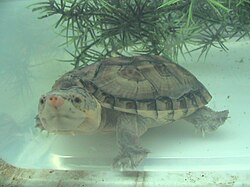Staurotypus
| Staurotypus | |
|---|---|
 |
|
| Chiapas giant musk turtle Giant musk turtle |
|
| Scientific classification | |
| Kingdom: | Animalia |
| Phylum: | Chordata |
| Subphylum: | Vertebrata |
| Class: | Reptilia |
| Order: | Testudines |
| Suborder: | Cryptodira |
| Superfamily: | Kinosternoidea |
| Family: | Kinosternidae |
| Genus: |
Staurotypus Wagler, 1830 |
Staurotypus is a genus of aquatic turtles commonly known as Mexican musk turtles, giant musk turtles, or three-keeled musk turtles. The two recognized species are found in Mexico and Central America.
S. salvinii is found primarily in Mexico, in the states of Oaxaca and Chiapas, but ranges south into Guatemala, El Salvador, and Belize. S. triporcatus is also found primarily in Mexico, and is more widespread, found in the states of Veracruz, Tabasco, Chiapas, Yucatán, and Campeche, and ranges south into Belize, Guatemala, and Honduras.
They are typically much larger than other species of Kinosternidae, attaining sizes of up to 36 cm (14 in) carapace length, with males being significantly smaller than females. They are typically brown, black, or green in color, with yellow undersides. Their carapaces are distinguished by three distinct ridges, or keels, which run their length.
Like other musk turtle species, they are carnivorous, eating various types of aquatic invertebrates, as well as fish and carrion.
...
Wikipedia
